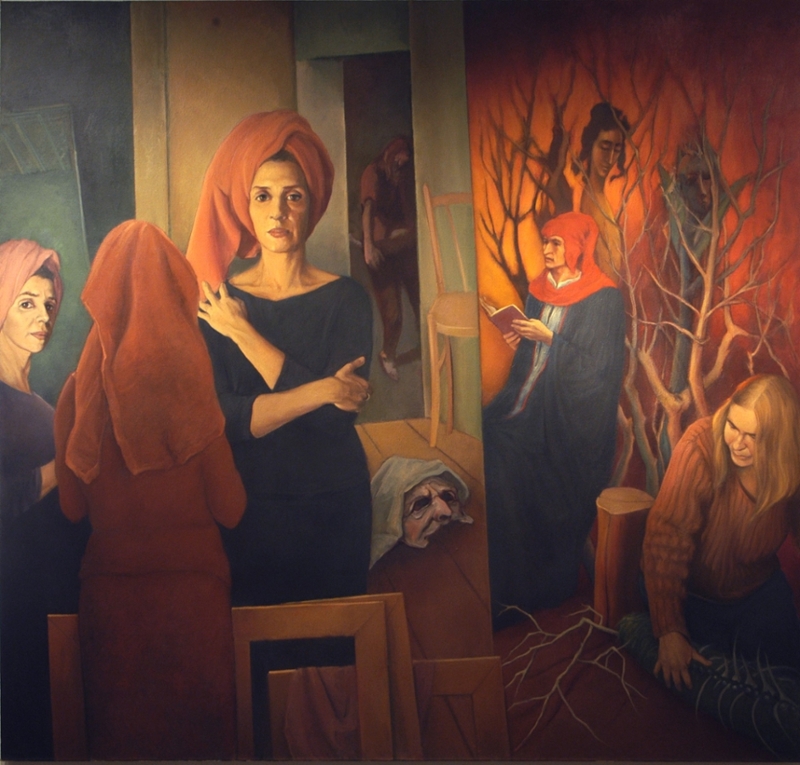
Tom Peterson
(American, 1930-2018), The Divine Comedy, 2001, Oil on canvas, Donated by the Family of Tom Peterson. 2019.5
A new acquisition to the permanent collection of the Rollins Museum of Art, son’s The Divine Comedy was donated to the museum by the family of the artist following his unfortunate passing. Peterson had a long history with Rollins College; he taught at Rollins as a Professor of Art from 1958 to 1992. Although initially trained in painting, Peterson expanded his artistic practice to include sculpture, photography, and printmaking, and frequently collaborated with other artists in the Orlando area.
This painting references the titular narrative poem by Dante Alighieri (1265-1321), a work of Italian literature originally published in 1320. Dante’s Divine Comedy chronicles the author’s supposed visit to the realms of the afterlife, narrated in first person. Towards the right of the composition, Dante the Pilgrim—the figure holding a book—traverses through Hell, indicated by the fiery orange background. Specifically, Peterson referenced the thirteenth canto of the Inferno, where Dante and his spiritual guide Virgil journey through the forest of the suicides in the seventh circle of Hell. In the Inferno, violence against oneself is punished by the transformation of the body into a tree where the mythical harpies nest. In the narrative, Dante plucks a twig from a gnarled branch, only to witness blood gush from the wound and the trunk angrily yelp at him.
Peterson indicated the grotesque transfiguration of humans into trees with the inclusion of two disembodied heads in the branches. However, according to Rima Jabbur—a current Professor of Art at Valencia College and frequent Peterson collaborator—the trees in the composition were also inspired by the sculptural artworks of Orlando-based artist Cheryl Bogdonovich. In a phone interview with Morgan Snoap, the Fred W. Hicks Curatorial Fellow at CFAM, Jabbur reported the critical response to Bogdonovich’s composite sculptures. Many viewers interpreted the branched creations as appearing “Hellish” or representing the mythical dryads.
On the opposite side of the painting, Beatrice–Dante’s deceased love and allegory of purity–is depicted in triplicate. Jabbur posed for Peterson as Beatrice, marking this canvas as a collaborative effort between numerous local artists. By repeating the vision of Beatrice, Peterson potentially underlined the importance of the number three in Dante’s source text as a reference to the Holy Trinity and the Judeo-Christian practice of Biblical numerology. Dante’s Divine Comedy is split into three cantiche—the Inferno (Hell), the Purgatorio (Purgatory), and the Paradiso (Heaven)—with each cantica containing exactly thirty-three cantos. Dante’s fascination with triplets even extended to the content of his Divine Comedy—at the end of the Paradiso, he recounted witnessing a triple rainbow, symbolic of the three arms of the Holy Trinity.
This obsessive and repetitive structure is subtly repeated in Peterson’s painting through the rough division of the canvas into thirds, each likely referencing a cantica of the titular subject. Save for a brief appearance at the end of the Purgatorio, Beatrice does not fill an active role in the story until the Paradiso, where she serves as Virgil’s replacement guide in the spheres of Heaven. Thus, the left side of the composition can be interpreted as representing the Paradiso, the right side symbolizing the Inferno, and the dark, recessed space between the two poles constituting the Purgatorio.
Ultimately, Peterson’s The Divine Comedy grapples with a literary behemoth that has pervaded the Christian imagination with its detailed, sometimes enthusiastic descriptions of eternal punishment and salvation. In one canvas, Peterson effectively chronicled Dante’s journey from Hell to Heaven, a journey that continues to captivate literary scholars to this day. Peterson’s The Divine Comedy faithfully represents select passages from its source text, standing as a carefully orchestrated yet spatially enigmatic contemporary reinterpretation of Dante’s 1320 masterpiece.
Isaac Gorres
Fred Hicks Intern
See Tom Peterson’s work on our Collection page.
